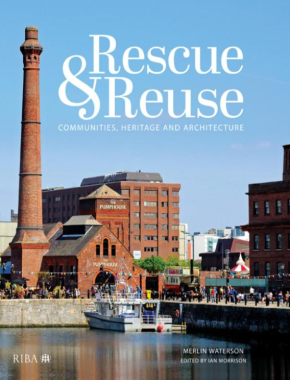Rescue and Reuse: communities, heritage and architecture
Rescue and Reuse: communities, heritage and architecture, Merlin Waterson, edited by Ian Morrison, RIBA Publishing, 2019, 166 pages, two black and white and 106 colour illustrations, hardback.
What do these buildings have in common: working-class houses, mansions, town halls, markets, chapels, castles, stables, shipyards, boathouses, barns, and cinemas? They, and many others, are rescued historic buildings that were facing the bulldozers or were left in a sad state of slow deterioration, which merely delayed the arrival of the bulldozers. Some buildings have lost their original functions. Others did not meet modern standards and regulations. Local authorities were unable to keep them because of the drastic cuts of funding. The private sector did not find them attractive for investment.
Rescue and Reuse is a heart-warming catalogue of success stories of community-led safeguarding and rehabilitation projects for historic buildings up and down the country. Communities refused to let go of historic buildings that gave a sense of place to their localities. Different types of buildings in various localities have been saved and were given new lives, thanks to vigilant local communities, visionary individuals, efficient building preservation trusts, resourceful architects, cooperative local authorities, and the funding from local and national bodies such as the Architectural Heritage Fund and Historic England.
The book consists of 10 chapters, according to the functions that were given to historic buildings after their restoration. Each chapter starts with a general discussion of the function in question, followed by case studies of prize-winning projects. This grouping is useful as it highlights the challenges and opportunities that are particular to a certain function. For example, the third chapter discusses rehabilitating historic buildings as private homes, which limits access to public and charitable funds because it does not permit public access.
On the other hand, bank loans and private sector funding could be an alternative if the newly created residences were in demand, and thus financially feasible. This could work with ‘revolving funding’ by using the proceeds of property sales in revitalisation projects for further properties. The last chapter makes the case for introducing conservation into the curriculum of architectural education. It also makes the point that government funding should be made available as it is the only possible way to save some categories of historic buildings. The text is easy to read, with plenty of photographs and no specialised jargon or technical details.
Rescue and Reuse demonstrates the feasibility of saving and reusing historic buildings, not only from an economic point of view, but more importantly, for their role in preserving a sense of community and the identity of place. It demonstrates that radical localism can secure sustainable conservation and revitalisation for the built heritage. The book is a great resource for local communities, decision makers, businesses and others who may be looking for inspiration, encouragement and ideas for giving historic buildings new roles for the future.
This article originally appeared as ‘At risk no longer’ in Context 166, published by the Institute of Historic Building Conservation (IHBC) in November 2020. It was written by Hossam Mahdy, international freelance consultant on the conservation of built heritage.
--Institute of Historic Building Conservation
Related articles on Designing Buildings Wiki
- Bletchley Park restoration.
- Conservation.
- Heritage.
- IHBC articles.
- Institute of Historic Building Conservation.
- Mews.
- Restoration v repair.
- Restoring Charles Drake's concrete house.
- Restoring Clitheroe Pinnacle.
- The creative re-use of historic prisons.
- The repair and restoration of Manchester Town Hall.
IHBC NewsBlog
Old Sarum fire in listed (& disputed) WW1 Hangar - Wiltshire Council has sought legal advice after fire engulfed a listed First World War hangar that was embroiled in a lengthy planning dispute.
UK Antarctic Heritage Trust launches ‘Virtual Visit’ website area
The Trust calls on people to 'Immerse yourself in our heritage – Making Antarctica Accessible'
Southend Council pledge to force Kursaal owners to maintain building
The Council has pledged to use ‘every tool in the toolbox’ if urgent repairs are not carried out.
HE’s Research Magazine publishes a major study of the heritage of England’s suburbs
The article traces the long evolution of an internal programme to research 200 years of suburban growth
IHBC Context 183 Wellbeing and Heritage published
The issue explores issues at the intersection of heritage and wellbeing.
SAVE celebrates 50 years of campaigning 1975-2025
SAVE Britain’s Heritage has announced events across the country to celebrate bringing new life to remarkable buildings.
IHBC Annual School 2025 - Shrewsbury 12-14 June
Themed Heritage in Context – Value: Plan: Change, join in-person or online.
200th Anniversary Celebration of the Modern Railway Planned
The Stockton & Darlington Railway opened on September 27, 1825.
Competence Framework Launched for Sustainability in the Built Environment
The Construction Industry Council (CIC) and the Edge have jointly published the framework.
Historic England Launches Wellbeing Strategy for Heritage
Whether through visiting, volunteering, learning or creative practice, engaging with heritage can strengthen confidence, resilience, hope and social connections.















